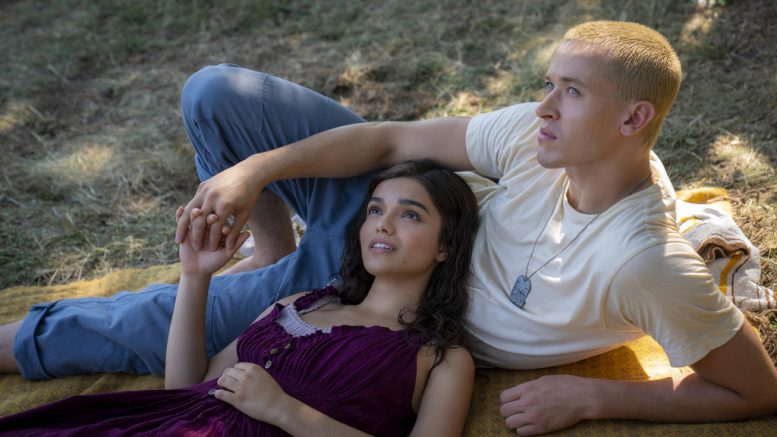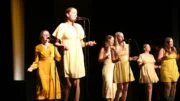The Associated Press
Two hours and 37 minutes is pretty long for a “ballad,” but you can’t call it “The Hunger Games: The Three-Cycle Opera of Songbirds and Snakes” now, can you?
Concision was never much in favor in the four “Hunger Games” films, which reached a seeming finale with 2015’s “The Hunger Games: Mockingjay — Part 2.” The intervening years have done nothing to shrink the ambitions of this unapologetically gaudy dystopic series where the brutal deaths of kids are watched over by outrageously styled Capitol denizens with names like Effie Trinket.
That clash of YA allegory and color palette is just as pronounced, if not more so, in “The Hunger Games: Ballad of Songbirds and Snakes,” a prequel set 64 years before the original books, adapted from Suzanne Collins’ 2020 book of the same name.
“The Ballad of Songbirds and Snakes,” which opens in theaters Nov. 16, is an origin story of the Hunger Games, themselves, as well as numerous characters — primarily the devious President Coriolanus Snow, played by Donald Sutherland in the first four films. Here, Snow is an impoverished but opportunistic 18-year-old student played by Tom Blyth.
Just as in the “Hunger Games” films led by Jennifer Lawrence’s Katniss Everdeen, the new one proves how much you can sacrifice in story when you’ve got a thrilling young performer commanding the screen.
Francis Lawrence’s prequel often wobbles, especially in the early going. And yet, in the end, “The Ballad of Songbirds and Snakes,” propelled by Blyth’s performance, manages to be the deepest expression yet of the series’ melodrama of adolescence. In Panem, the only thing more tragic than the suffering inflicted by adults on the young may be a bright kid warping wickedly into one of those elders, too.
That generational divide was always at the heart of the appeal of “The Hungers Games,” a fantasy where no adult or institution can be trusted, and the normal pressures of teendom are amplified in a modern, televised Roman Coliseum — an “American Idol” with murder — concocted by elders. It’s madness shrugged off as, “That’s just the way it is.”
In “The Ballad of Songbirds and Snakes,” we see how it got to be that way. The 10th annual Hunger Games are approaching but it feels more like pre-Super Bowl times when the NFL and the AFL played in separate leagues. The broadcast is low rent, the ratings are poor and the games themselves are staged in a dilapidated stadium.
With little food in the fridge, Coriolanus is living with his cousin Tigris (Hunter Schafer) and grandmother (Fionnula Flanagan). Their family has fallen on hard times, in part because of a family rivalry with Casca Highbottom (Peter Dinklage), the dean of the academy who harbors hatred for the Snows. (Dinklage, whose wry presence adds a kick to the film, has managed to appear once again in an outlandish fantasy with a man named Snow. )
As the students gather amid Third Reich architectures (the production design by Uli Hanisch is stellar) and the games’ founder Volumnia Gaul (Viola Davis, majestic in blue, with a turquoise eye) gazes on, Coriolanus is assigned his tribute, Lucy Gray Baird, a bold young woman from District 12 (also the home of Katniss) who wears a rainbow skirt and sports a dubious Southern accent. During the reaping ceremony, she makes an immediate impression, putting a snake down the back of a rival and bursting into song for the cameras. See, now there’s concision, I thought. You get your songbird and snake, straight off.
Lawrence’s Katniss was a thrilling female warrior whose seizing of center stage had reverberations off screen, paving the way for blockbuster female protagonists. Rachel Zegler’s Lucy Gray is inevitably a disappointment by comparison. Lawrence’s film, scripted by Michael Arndt and Michael Lesslie, for a while has the stale feeling of an unneeded retread. The tonal fluctuations, always a tricky balance in Panem, can be ridiculous. The stadium is abruptly bombed by unseen rebels. Once the games begin, one tribute concocts rabies.
The main thing holding our attention at this point is Jason Schwartzman’s Lucretius Flickerman, a TV host with a Salvador Dali mustache who wants the games wrapped up just so he can make his dinner reservations. (It’s been a very good year for Schwartzman, who transformed himself in Wes Anderson’s “Asteroid City” and transmogrified in “Spider-Man: Across the Spider-Verse.” )
But “Songbirds and Snakes” sneakily begins making a case for itself. The relationship between Coriolanus and Lucy Gray is compellingly complex. He works desperately to help her survive the games because he believes in her, and maybe loves her, but also because her success benefits him, too. Whether Lucy Gray is as purehearted as her songs, too, is up for debate. Both, we sense, are cunningly playing the hands they’ve been delt, seeking an advantage where they can. When Coriolanus begins making suggestions for the games to Volumnia, he proves himself a natural-born marketer.
That there’s tension in Coriolanus’ character, considering we know how he ultimately ends up, is a tribute to just how good Blyth is. We’ve by now seen plenty of prequels that show us how some famous villain broke bad, but there’s nothing in Blyth’s performance that telegraphs his future. He’s a sincere striver — we root for him because of his poverty and his puck — who’s operating in the society he’s found himself. He’s a villain born entirely of circumstance.
“The Ballad of Songbirds and Snakes” extends the saga for a third act that takes places in District 12, an addition that another franchise might have saved for the next installment. But it’s also where that tragedy of “The Hunger Games,” and Coriolanus’ fate, earns some of the Shakespearean touches that have liberally been sprinkled throughout. (Shakespeare’s “Coriolanus,” is likewise about an ambiguous warrior set amid times of famine and class struggle.)
“The Hunger Games” kicked off a YA craze in film that had its ups and downs but petered out several years ago. Whether “The Ballad of Songbirds and Snakes” is enough to relight those embers remains to be seen, but it is a reminder how good a platform they offered young actors. It’s a ritual worth returning to.
“The Hunger Games: The Ballad of Songbirds & Snakes,” a Lionsgate release is rated PG-13 by the Motion Picture Association for strong violent content and disturbing material. Running time: 157 minutes. Two and a half stars out of four.







































